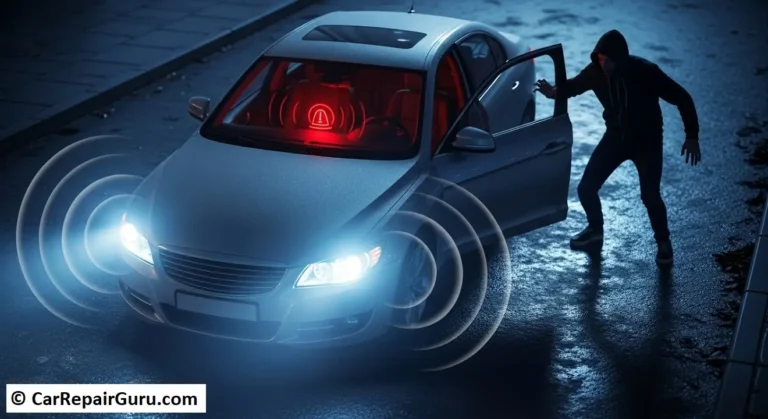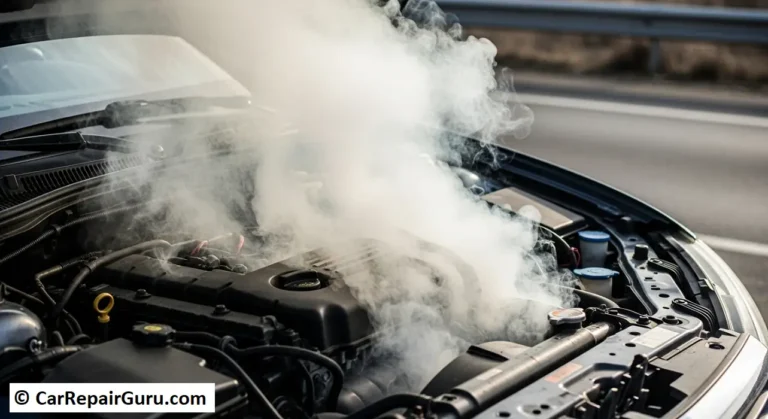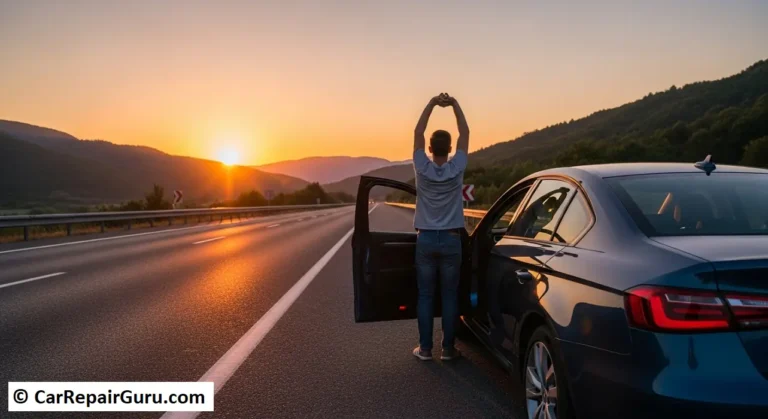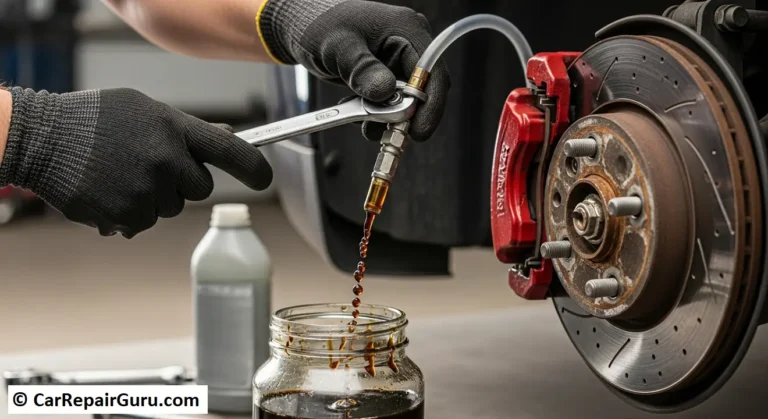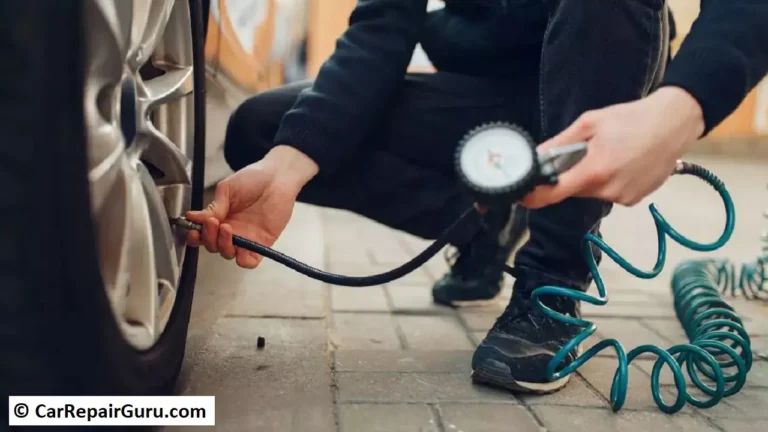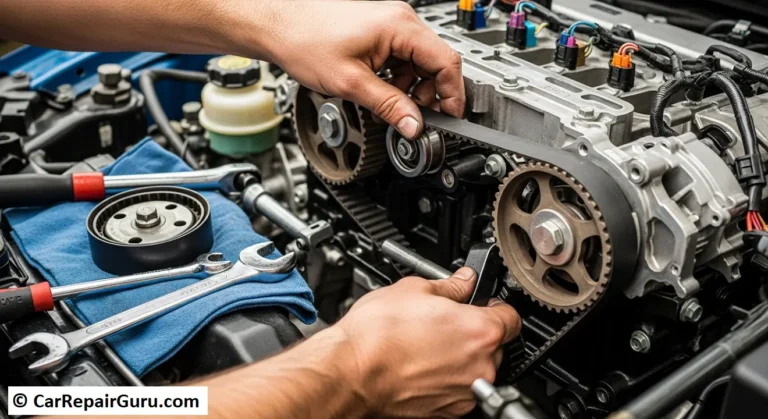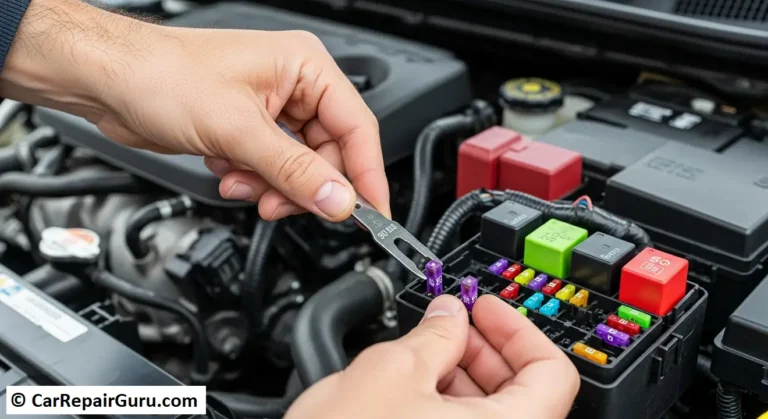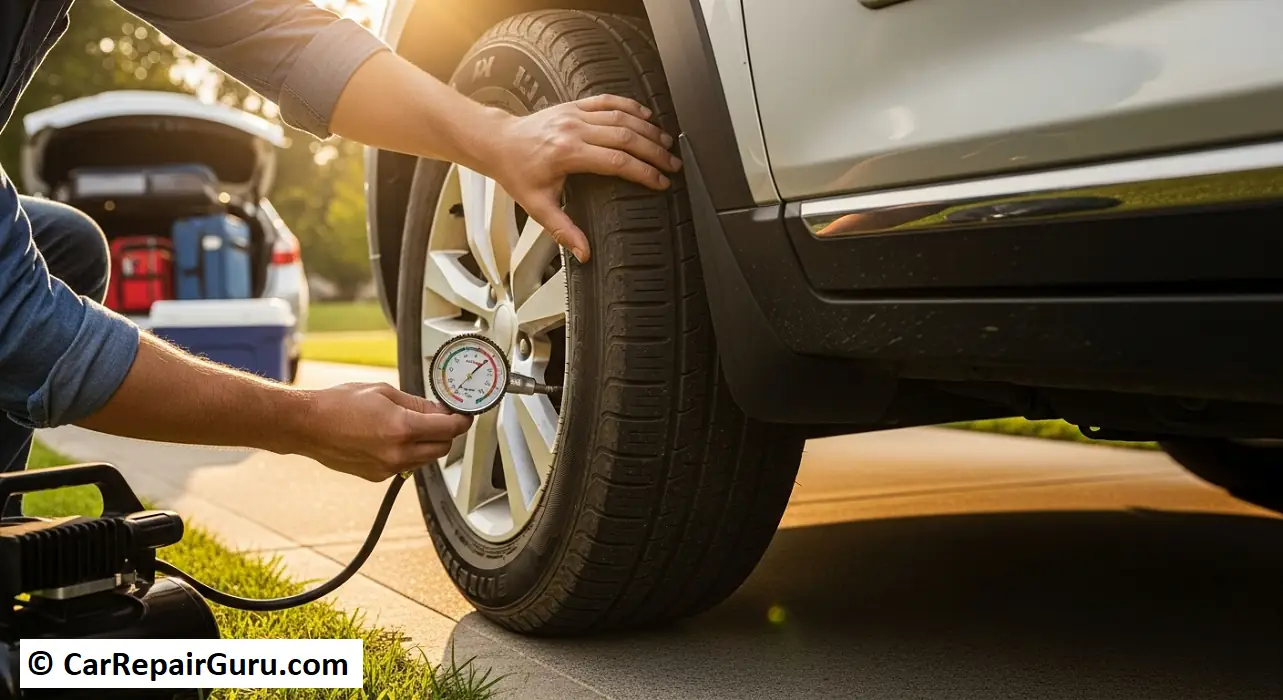
The open road is calling. The playlists are made, the snacks are packed, and the promise of new sights and unforgettable memories is just ahead. But amid all the excitement, there’s a quiet question that can creep into any driver’s mind: Is my car ready for this?
Let’s be honest—nothing deflates the joy of a road trip faster than the sound of a sputtering engine or the sight of a flat tire on the side of a highway, miles from the nearest town. These moments don’t just delay your vacation; they can be stressful, expensive, and even dangerous.
That’s where this guide comes in. A little bit of preparation goes a long way. By performing these 10 essential car safety checks for a road trip, you’re not just doing routine maintenance; you’re investing in peace of mind. This comprehensive vehicle safety checklist will ensure your car is as ready for adventure as you are, transforming potential anxiety into pure, confident excitement for the journey ahead.
The Top 10 Pre-Road Trip Car Safety Checks – Your Essential Vehicle Checklist
Some of these checks are simple enough for anyone to do in their own driveway in under 30 minutes. For others, you might want the keen eye of a professional. Let’s dive in and get your vehicle road-ready.
Check #1 – Tires – Your Only Connection to the Road
Why it’s important: Think about it—your tires are the only part of your vehicle that actually touches the road. Their condition is directly linked to steering, braking, and overall stability. Tire failure is one of the leading causes of roadside breakdowns and serious accidents, making this check your absolute top priority.
What to do:
- Check Tire Pressure (PSI): Don’t use the number on the tire’s sidewall; that’s the maximum pressure the tire can hold. For the correct pressure, look for the sticker inside your driver’s side door jamb or in your owner’s manual. Check the pressure with a reliable gauge when the tires are “cold” (before you’ve driven for the day). Properly inflated tires ensure better handling, fuel economy, and a safer ride.
- Inspect Tread Depth (The Penny Test): A car’s tread grips the road, especially in wet conditions. You can easily check it with a penny. Insert the penny into a tread groove with Lincoln’s head upside down. If you can see the top of Abe’s head, your tread is worn down to a dangerous level (below 2/32 of an inch), and it’s time for new tires.
- Examine for Damage: Walk around the car and visually inspect each tire. Look for any cracks in the sidewall, unsightly bulges, or objects like nails or screws embedded in the tread.
- Don’t Forget the Spare: The most forgotten tire is often the one you need most in an emergency. Make sure your spare tire is properly inflated and in good condition. You should also verify you have a jack and lug wrench.
Check #2 – Brakes – Your Most Important Safety System
Why it’s important: This one is a no-brainer. Your ability to stop safely and effectively is the most critical safety function of your car. Neglecting your brakes is simply not an option, especially when you’ll be driving in unfamiliar areas or at highway speeds.
What to do:
- Listen for Noises: When you drive, turn the radio down and listen. Do you hear a high-pitched squeal, a harsh grinding sound, or a scraping noise when you apply the brakes? These are all tell-tale signs that your brake pads or rotors need immediate attention.
- Feel for Vibrations: Pay attention to how the car feels when you brake. If you notice a pulsing or vibrating sensation in the brake pedal or the steering wheel, it could indicate warped rotors.
- Check Brake Fluid: Look for the brake fluid reservoir in your engine bay (your owner’s manual can show you where). The fluid should be at the “full” line and a clear to light amber color. If it’s dark brown or black, it’s time to have it flushed and replaced. Low fluid could also signal a leak in the system, which is extremely dangerous.
Check #3 – Fluids – The Lifeblood of Your Vehicle
Why it’s important: Your car relies on a variety of fluids to cool, lubricate, and power its most critical components. Running low on any of them is a recipe for overheating or catastrophic engine damage. This is a core part of any car maintenance before a long drive.
What to do (always check fluids on a level surface):
- Engine Oil: With the engine off and cool, pull out the dipstick, wipe it clean with a paper towel, re-insert it fully, and pull it out again. The oil level should be between the “Full” and “Add” marks. The oil should be honey-colored; if it’s dark, gritty, or milky, it’s time for an oil change.
- Coolant/Antifreeze: Crucial: Only check this when the engine is completely cool. Opening the radiator cap on a hot engine can cause serious burns. Check the level on the see-through overflow reservoir. If it’s low, top it off with the correct type of coolant for your vehicle (check the manual). This fluid prevents your engine from overheating in summer traffic and freezing in the winter.
- Windshield Washer Fluid: This might seem minor, but clear visibility is a major safety factor. A sudden splash of mud or a swarm of bugs can completely obscure your view. Top off the reservoir before you go.
Check #4 – Battery – The Heart of Your Car’s Electronics
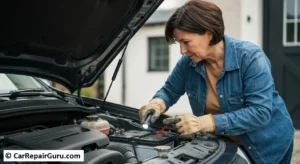
Why it’s important: Your road trip won’t even begin if your battery is dead. Modern cars rely on the battery for everything from starting the engine to powering GPS, music, and A/C. Extreme temperatures can be especially hard on batteries.
What to do:
- Check the Terminals: Pop the hood and look at the battery terminals (the positive and negative posts). If you see any fuzzy, white, or blueish stuff (corrosion), you can clean it off with a wire brush and a baking soda/water solution. A clean connection ensures a solid flow of power.
- Test the Charge: If your battery is more than three years old, it’s a great idea to get it tested. Most auto parts stores will perform a free battery health test. It only takes a few minutes and can save you from being stranded.
Check #5 – Lights & Wipers – See and Be Seen
Why it’s important: Your ability to see the road and for other drivers to see you is paramount, especially when driving at night or through bad weather. A single burnt-out brake light can lead to a traffic ticket or, worse, a rear-end collision.
What to do:
- Test All Exterior Lights: Grab a friend or family member to help. Have them stand outside the car as you test your headlights (both high and low beams), turn signals, brake lights, and reverse lights. A quick walk-around is all it takes.
- Inspect Wiper Blades: Look at your wiper blades. Are they cracked, torn, or brittle? Run them with some washer fluid. If they leave streaks or chatter across the windshield, replace them. It’s an inexpensive and easy fix that makes a world of difference in a rainstorm.
Check #6 – Belts & Hoses – The Unsung Heroes
Why it’s important: The rubber belts and hoses snaking through your engine bay are responsible for running everything from the alternator to the water pump. If one of them snaps or bursts, it can cause an instant breakdown and potentially severe engine damage.
What to do:
- Visual Inspection: With the engine off, look at the visible belts. You’re searching for any signs of cracking, fraying, or a shiny, glazed appearance. Gently squeeze the larger radiator hoses. They should feel firm, not rock-hard, brittle, or mushy.
Check #7 – Air Filter – Let Your Engine Breathe
Why it’s important: Just like you, your engine needs clean air to perform at its best. A clogged engine air filter can reduce your fuel efficiency and hamper acceleration—the last things you want on a long trip.
What to do:
- This is one of the easiest DIY checks. The air filter is usually in a black plastic box near the top of the engine that’s easy to open with clips or a few screws. Take the filter out and hold it up to a light. If you can’t see light passing through it, it’s time for a new one.
Check #8 – Air Conditioning (A/C) – Your Comfort & Safety System
Why it’s important: A working A/C system is more than just a creature comfort; it’s a safety tool. Driving in a hot, stuffy car can lead to fatigue and reduced concentration. Plus, the A/C system is essential for quickly defogging your windshield in humid or rainy weather.
What to do:
- Start your car and turn the A/C on its highest setting. Does it blow cold air within a minute or so? If it’s blowing cool but not cold, or warm air, it may just need a refrigerant recharge.
Check #9 – Pack an Emergency Kit
Why it’s important: Even with the best preparation, the unexpected can happen. Having a well-stocked emergency kit in your trunk is your guardian angel, providing the tools you need to handle a minor issue or stay safe while you wait for help.
What to include:
- Jumper cables or a portable jump starter
- A well-stocked first-aid kit
- A powerful flashlight with extra batteries
- A basic tool kit (multi-tool, screwdrivers, adjustable wrench)
- A tire pressure gauge and a portable tire inflator
- Reflective safety triangles or road flares
- Work gloves, a poncho, and a blanket
- Bottled water and non-perishable snacks
Check #10 – Check Your Paperwork
Why it’s important: The last thing you want during a routine traffic stop in an unfamiliar state is to be fumbling for expired documents. This check is quick, easy, and can save you a major headache.
What to check:
- Ensure your driver’s license is not expired.
- Confirm your vehicle registration is current.
- Have a physical or digital copy of your proof of insurance. Keep it easily accessible in your glove compartment.
When to See a Professional Mechanic
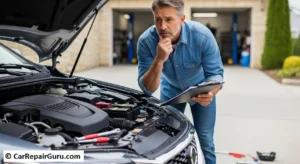
Feeling a bit overwhelmed? Don’t be. If you’re uncomfortable performing any of these checks, hear a strange noise you can’t identify, or see a persistent warning light on your dash, it’s the perfect time to schedule a pre-road trip car inspection with a trusted mechanic. They can give your vehicle a thorough look-over, from the suspension to the exhaust system, providing the ultimate level of assurance before you hit the road.
Your Adventure Awaits
Your road trip should be about the destination, the journey, and the people you share it with—not about worrying over every strange noise your car makes. By investing just a little time in these top 10 car safety checks for your road trip, you are setting yourself up for a smooth, safe, and memorable adventure.
Now that your car’s health is in order and your road trip preparation is complete, it’s time for the fun part. Hit the open road, turn up the music, and drive safe. Your worry-free journey awaits!
Frequently Asked Questions (FAQ)
What is the most important car check before a road trip?
While all are vital, checking your tires is the single most critical task. Proper tire pressure and adequate tread depth directly impact your vehicle’s handling, braking, and overall safety on the road.
Should I get an oil change before a long road trip?
Check your maintenance sticker and your dipstick. If you are within 1,000 miles of your next scheduled oil change or if the oil appears dark and gritty, it’s a wise investment in your engine’s health.
How do I check my tire pressure for a road trip?
Use a reliable gauge on cold tires (before driving for the day). Find the correct PSI on the sticker inside your driver’s door jamb and fill each tire, including the spare, to that recommended level.
What should I pack in my car for a road trip emergency?
Every car should have an emergency kit with jumper cables, a first-aid kit, a flashlight, and reflective triangles. A portable tire inflator and a basic tool kit are also excellent additions for handling minor issues.
When should I take my car to a mechanic before a road trip?
If you notice any warning lights, hear unusual noises like grinding brakes, or feel unsure about performing any of the checks yourself, schedule a professional pre-trip inspection for complete peace of mind.
